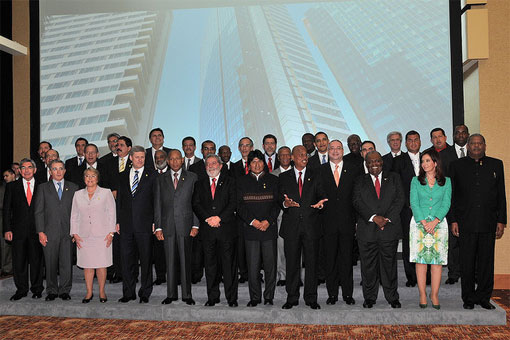April is Western Hemisphere month for U.S. President Barack Obama, and the capstone event is this weekend’s Sixth Summit of the Americas, a regular meeting of the 34 democratically elected presidents and prime ministers of the hemisphere. Originally scheduled to arrive in Cartagena, Colombia, on Saturday, Obama will now arrive one day earlier to get a head start on bilateral meetings with his regional counterparts.
In the lead-up to the Summit, Obama met with Mexican President Felipe Calderón and Canadian Prime Minster Stephen Harper on April 2 for the latest round of the North American Leaders’ Summit. The three leaders pledged to make our integrated North American economy more competitive. Then, on April 10, Brazilian President Dilma Rousseff made an official visit to Washington to discuss the economy, energy, education, and other areas of joint concern. Her visit, coming one year after Obama’s trip to Brasília and Rio de Janeiro, yet again highlighted the increasing clout of the world’s sixth-largest economy.
But beyond the one-off focus around these meetings, most Americans are missing out that Latin America is booming. Eighty percent of Latin America’s 500 million people live in countries where the economies are consistently growing faster than in the United States. These are, for the most part, middle-class countries eager to buy the products we export. Forty percent of U.S. exports go to the Western Hemisphere, including Canada. Standard & Poor’s rates the sovereign debt of the Bahamas, Barbados, Brazil, Chile, Colombia, Mexico, Panama, Peru, Trinidad and Tobago, and Uruguay as investment grade, while Canada is rated higher than the United States. More than half our imported oil comes from this hemisphere.
These are some of the reasons why hemispheric cooperation is necessary.
I’ve attended three of the five previous Summits of the Americas, the most recent of which took place in April 2009 in Port-of-Spain, Trinidad and Tobago, where I served as chargé d’affaires at the U.S. embassy. I love the Summits, but the media and mainstream America can’t quite figure out what to make of them. Here’s the low down.
All summits make decisions on the basis of consensus. The greater the number of countries attending the summit, the harder that consensus is to reach. So don’t look for the final communiqué to break ground on this year’s theme, “Connecting the Americas: Partners for Prosperity.” It is negotiated well in advance by platoons of bureaucrats.
Leaders are unlikely to change long-held views in Cartagena. The Brazilians are not going to suddenly initiate negotiations on a free-trade agreement with the United States. President Obama is not going to sign on to Guatemalan President Otto Pérez Molina’s proposal to legalize drugs. Venezuelan President Hugo Chávez is not going to stop being his Bolivarian self.
While U.S. initiatives in Cartagena will be lauded by the White House press secretary as earth shaking, don’t count on it. There will be no Marshall Plan for Latin America or a new Alliance for Progress; the U.S. can’t afford them and they would be inappropriate. With the important exception of Haiti, the Americas are comprised of mostly middle-income countries. Their solutions will come from within, but the United States can be a genuine partner in those efforts, and doing so is in our national interest.
What is important is what will likely go unreported by the media: the myriad of small—but important—“inside baseball” issues that can potentially improve the lives of millions in the hemisphere. This includes accelerating energy integration, improving security for ordinary citizens against criminal gangs, and making it easier for small- and medium-sized businesses to grow and enter export markets.
Small ball is how most baseball games are won. It is how millions of people moved out of poverty in the hemisphere over the past two decades. And it is likely to be what will keep the Americas growing. If it’s small ball, why not just link leaders with Skype? The Summit is important. That’s why.
Groups of nations hold summits for the same reason that families come together for the holidays. It demonstrates that the relationship will endure for the long haul. Just as relatives cannot be chosen, we remain neighbors with the nations of the hemisphere no matter what happens. That’s what families and diplomacy are all about: coming together, talking and trying to understand different perspective. And, just like those family reunions, it’s the kitchen conversations and exchanges on the back deck that are often most important.
Multilateral summitry forces our leaders to meet with those with whom they don‘t agree. The side conversations at meals, in the hallways, after and before the formal meetings—carefully arranged “bilats” and “pull asides”—are where the important work is done. It is how presidents and foreign ministers convey messages to countries with which they have difficult relations. It is how positions on Syria or Iran or North Korea are discussed in a meeting that is ostensibly about the Western Hemisphere.
And just like family gatherings, there is also a celebratory aspect to Summits of the Americas. For Colombia, the host of the Summit, this weekend’s meetings will be the diplomatic equivalent of the Olympics or the World Cup. It is an opportunity to celebrate all that Colombia has achieved in building a self-sustaining democracy where the economy is booming and the poverty level is dropping rapidly. The leaders will also emphasize what the countries of the Americas have in common. And like families, it is where we hope that the industry and hard work of the successful nations will rub off on the laggards.
Summit of the Americas? What a great idea. It has the power to change our hemisphere. One step at a time.






